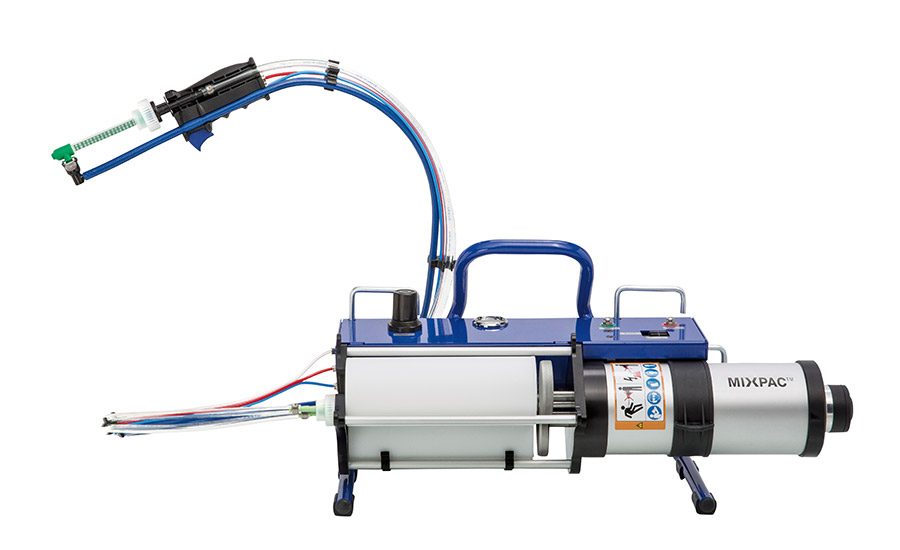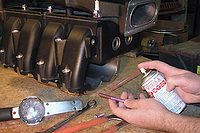Improving Coating Efficiency with Dispensing Technology
Applicator-friendly cartridge-based coating dispensing technologies can help reduce labor, waste, and disposal costs.


With a cartridge-based system, coating is packaged in pre-loaded and pre-proportioned mix ratio cartridges, ensuring the exact mix ratio of 2-component coatings.


In response to environmental concerns, many industries are moving from protective coating products containing solvents to 100% solid epoxies and urethanes. These new materials set and cure faster, but they are challenging to apply. However, applicator-friendly cartridge-based dispensing technologies are available that reduce labor, waste, and disposal costs.
With almost 100% efficiency and hardly any liquid waste, the technology is especially appropriate for smaller quantity applications like grooming, touchups, repairs, stripe coatings, and field joint coating. According to a recent evaluation, one shipyard would achieve a return on investment (ROI) in only 18 months by switching to cartridge-based systems.
Standard Adhesive Coating Dispensing Technologies
For many years, most single-component protective coatings had significant issues with abrasion resistance, chemical resistance, and durability. With complex 2-component coating technology, mixing and metering issues are now quite common with the use of drill mixers or paddles.
Standard methods for applying 2-component protective coatings include airless spray, conventional spray, and brush and roll, which all require proper mixing. The other option is the use of plural-component spray equipment. These technologies are still viable for large-volume applications that require material to be purchased in drums. However, for smaller quantity and small packaging applications, like touchup coating/repair, and pipeline applications, cartridge-based systems can be a better option—and one that can save time and money.
Comparing Efficiency
Standard protective coating technologies often result in inefficiency when used for smaller quantity applications. Human error, waste, speed, health and safety, solvent use, and limited access are the major factors to be considered.
These issues were documented in a recent in-depth coatings cost analysis conducted in an American shipyard that performs daily epoxy touchups and repairs for naval ships. The study compared standard protective coating practices with three members of a cartridge-based 2-component dispensing system family.* It identified the areas where the technology adds the greatest value.
*Sulzer’s MIXPAC™ MixCoat™ cartridge-based 2-component dispensing system family.
Human Error
Human error is a major cause of inefficiency in a manual metering and mixing process. Applicators tend to eyeball tricky ratios. With or without using measuring cups, they can be off by at least 10%, and sometimes even more.
Uncured coatings are a major issue at shipyards. In the shipyard studied, improper mixing and metering resulted in coating removal, extra rework, and repairs. Mixing stations were often found to have not followed mixing procedures and directives, and metering cups were often either not used or used improperly. As a result, the shipyard often issued Non-Compliance Reports (NCRs) and costly Corrective Action Reports (CARs) regarding work that had to be rectified.
The evaluation showed that switching to a cartridge-based system would eliminate the hand-mixing process and significantly reduce NCRs and CARs. With a cartridge-based system, coating is packaged in pre-loaded and pre-proportioned mix ratio cartridges, ensuring the exact mix ratio of 2-component coatings. The coater is able to apply almost all of the mixed coating, taking coating cartridges to the specific job site.
Waste
Waste is another important issue affecting efficiency. The standard practice is to mix an entire coating “kit,” which contains all of the resin and catalyst. Unfortunately, coating kit sizes often do not accurately reflect the project size, which leads to improper metering and wasted coating.
Time is limited when applying a two-component coating after the kit is mixed. When too much coating is mixed for a job, the pot life tends to expire before the entire amount can be applied. Nearly 40% of coatings used for maintenance, repair and touchup is wasted, resulting in expensive disposal and environmental fees.
Speed
Speed is the biggest challenge with manual mixing. When working with a brush on a task like stripe coating, operators must meter the product, mix it, and then travel to the project site. By contrast, with a cartridge system, setup and cleanup time is minimal, improving efficiency. No time is wasted traveling from the job site to the coating mixing station.
This is especially true with recent advances in manual gun and brush technology. Once pumped through, the operator can apply the material immediately, no longer having to take time to dip the brush into a bucket. The operator also gains a free hand, improving worker ergonomics and safety. In the shipyard study, the brush system saved 40% over the standard method of mixing and metering, dipping into a bucket, and brushing on the product.
The time savings could also be significant for a pipeline repair project. Rather than continually needing a truck to move large and bulky plural-component spray equipment that weighs hundreds of pounds, an operator could simply use an airline and move down the pipeline.
Health and Safety
Working out of an open bucket may result in potential worker health and safety issues. With a closed-loop cartridge-based system, material is contained until it is dispensed. This limits exposure to fumes and solvents, prevents the introduction of contaminants into the coating, and reduces the likelihood of spills. In addition, the lightweight ergonomic design includes a shoulder strap, enabling workers to have a free hand when performing rope work or for touchup teams working on the side of offshore oil rigs.
With the new coating dispensing system, the coating material is not as atomized as when sprayed out of an airless unit or expensive spray equipment. This also helps to reduce health risks from fumes.
Solvent Use
Many traditional coating technologies require the use of solvents to flush out spray lines. In addition, applicators sometimes use a solvent to thin products to make them more applicator friendly.
With the cartridge systems, consumables are all disposable and nothing needs to be cleaned. No solvent is needed for thinning; solvent use is limited to wiping down equipment to remove any overspray.
Limited Accessibility
Efficiency is also affected by the need for coating areas with limited accessibility for standard spray equipment. These areas include tanks and bilges in marine applications, as well as water and sewer manhole applications. Rather than having to brush and roll in small areas with complex geometry, coaters can use the lightweight and mobile cartridge-based 2-component dispensing system to reach into those tight and angled spaces.
The Bottom Line
The shipyard evaluation determined that the use of cartridges saved 1.9 man hours per coating event, or about $129. With a coating department consisting of several hundred coaters, and approximately 100 coaters conducting two coating events per day on all shifts, there were 200 coating events per day—or 1,000 coating events per week. This equals about 50,000 coating events per year.
Avoiding $129 per event per year is a savings of about $6.45 million. The evaluation showed the cartridge system added the most value to shipboard touchups; grooming, striping, and repairs; block assembly and secondary outfitting complex geometries; and plate assembly paralleling erection of blocks.
Also evaluated was the reduction in wasted coating for touchups, repairs, stripe coating, and shipyard manual tasks. As noted, mixing stations often mixed more coating than needed for applications, which resulted in excess and wasted coating. Approximately 3/8 of a gallon of paint was disposed of at each of the 200 coating events per day, the equivalent of 28 gal of coating per day. With 50,000 coating events per year, the potential cost savings equals about $970,000 per year.
The study also analyzed the cost impacts of applying uncured coating. Results showed that 2% of coating installs are defective, requiring the generation of NCRs and a need for labor to remove uncured coating and apply new material to the defective areas. The analysis estimated about 1,000 events per year, resulting in about $ 2.25 million in labor and material costs for removing and recoating these areas. Using cartridge technology will significantly reduce these costs.
Finally, the shipyard analysis included a hazardous waste reduction analysis. The shipyard generates about 18,750 gal of coating waste per year, which is consolidated into 340 drums of 55 gal each. Pickup, processing, and hazardous waste disposal of the drums at a cost of $300 per drum results in $102,000 in disposal costs that can be avoided if a cartridge system is used.
The total cost of current processes at the shipyard was estimated to be about $9.7 million. An initial investment cost for the coating cartridge process was about $546,000, resulting in an ROI in about 18 months.
Summing It Up
While many applications will continue to require the greater material volumes available in drums, cartridge-based coating packaging improves efficiency in niche markets in the aerospace industry, marine touchup coating and repair, pipeline, and manhole applications. In many cases, it complements traditional methods, reducing labor, material, and disposal costs.
For more information, visit www.sulzer.com.
Looking for a reprint of this article?
From high-res PDFs to custom plaques, order your copy today!







